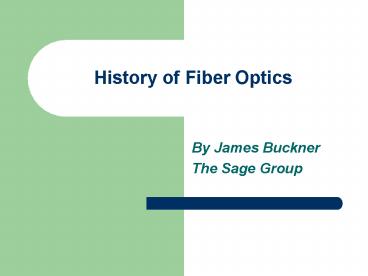History of Fiber Optics - PowerPoint PPT Presentation
1 / 24
Title:
History of Fiber Optics
Description:
History of Fiber Optics By James Buckner The Sage Group ... it became the forerunner to a networking technology called Free Space Optics, or FSO. – PowerPoint PPT presentation
Number of Views:1982
Avg rating:3.0/5.0
Title: History of Fiber Optics
1
History of Fiber Optics
- By James Buckner
- The Sage Group
2
1854 John Tyndall
- First Guided transmission of light
- Used basin with hole in bottom to direct stream
of water. - Sunlight was refracted through the stream of
water.
3
1880 William Wheeling
- Used mirrored pipes to carry light from one
source to many rooms. - Did not take off because of Edisons incandescent
light bulb gained widespread popularity.
4
1880 Alexander Graham Bell
- Invented the photophone, a device to carry voice
signals through the air instead of wires. - While the photophone did not materialize, it
became the forerunner to a networking technology
called Free Space Optics, or FSO. FSO uses lasers
and detectors to transmit data between buildings
without wires.
5
1920 First attempt with optical transmissions
- John Logie Baird (England) and Clarence W.
Hansell (U.S.) jointly file patent for a method
to carry television images through transparent
pipes. - Images were transmitted in 1933. It was a very
short distance, but the quality was very, very
low.
6
1954 Invention of modern optical fiber
- Abraham van Heel covered a bare glass fiber with
a transparent coating. - This coating, later called cladding, had a lower
refractive index than the bare fiber. - The result was that the light was contained in
the fiber and did not leak out.
7
1960 Medial Imaging Invention of the Laser
- Fiberscope allowed for the inspection of boilers
and medical imaging. - Laser was invented this year.
- Optical Fibers had losses of 1 dB/meter.
- http//www.spectrum-instruments.com/products/optic
al/industrial.shtml
8
Telephone company demands
- Telephone companies were interested in optical
fiber. - Possible bandwidth increases were possible with
the invention of the videophone. - Telephone companies wanted losses of no more than
10 20 dB/km.
9
The proposal that started it all
- Charles K. Kho was an engineer with Standard
Telecommunications Laboratories. - He proposed in 1966 that communications were
possible with single mode fiber. - This presentation was made to the Institute of
Electrical Engineers (now IEEE) - Attenuation of less than 20 dB/km was possible
with optical fiber
10
1970 Corning Glass Invents Optical Fiber
- Inventors Keck, Maurer, Schultz
- Single mode fiber at 633 nm wavelength
- Attenuation below 20 dB/km
11
1977 Phone Companies Use Optical Fiber
- Used multimode fibers at first
- Transmission rates of 6.2 Mb/s and 45 MB/s
- First generation systems 850 nm wavelength 2
dB/km attenuation - Second generation systems 1300 nm wavelength
0.4 dB/km
12
1980 Bell Labs Proposes First Fiber
Transatlantic Cable
- TAT-8 transatlantic cable proposed
- Uses single mode fiber
- Speed 565 Mb/second over 2-pair fiber
13
1984 Everything Changes
- Modified Final Judgment splits ATT into seven
Regional Bell Operating Companies - First wave of deregulation hits telephone
industry - Microwave Communications Inc. (MCI) looks to
single mode fiber for its communications - MCI terrestrial systems operate at 1300 nm at 400
Mb/sec. Amplifiers are spaced every 50 kilometers.
14
1988
- ATT activates TAT-8
- 1300 nm becomes standard for fiber optic systems.
15
1992
- 1550 nm systems appear for the first time.
- Transatlantic cable TAT-10 activated
- Fiber attenuation now at 0.2 dB/km at 1550 nm
16
New optical amplifiers appear
- Erbium Doped Fiber Amplifiers are now available.
- EDFAs allow for optical amplification without
conversion to electrical and back again. - Wave Division Multiplexing now possible.
17
Fiber Optic Cable Attenuation(Long-haul fiber)
18
1996 The Internet boom begins
- Transatlantic cable TAT-12/13 activated. Data
rate is 5 Gb/second. - Netscape, maker of the Netscape browser, goes
public and starts the Dot.Com boom. - Telecommunications Act of 1996 signed into law.
The Act forces the incumbent telephone companies
to open their networks to competition. - Competitive Local Exchange Carriers open for
business.
19
1998 More innovations
- Dense Wave Division Multiplexing (DWDM) systems
become widely available. Some systems have an
aggregate capacity of 10 Gb/second. - Optical fiber is placed in the ground at
phenomenal rates. - Digital Subscriber Lines become available at much
faster rates than dial-up connections. - Dot.com boom shows no signs of stopping.
20
Wave Division Multiplexing Systems
21
Projected Internet Growth through 2005
22
2001 The bubble bursts
- DWDM systems can now transmit 100 waves at 10
Gb/sec. The aggregate capacity is now 1 terabit
per second. - Telecom bubble bursts
- Global Crossing, Worldcom, and Enron see heavy
losses. Enron files for bankruptcy.
23
2002 Present
- Stronger companies like Level(3) and Qwest bought
up smaller players and assets of bankrupt fiber
communications companies. - More households have high speed connections than
the dot.com era. - MCI merges with Verizon. Verizon also launches
FiOS, which is fiber to the home. - SBC manages to unite four of the seven RBOCs and
ATT into one company.
24
Questions































